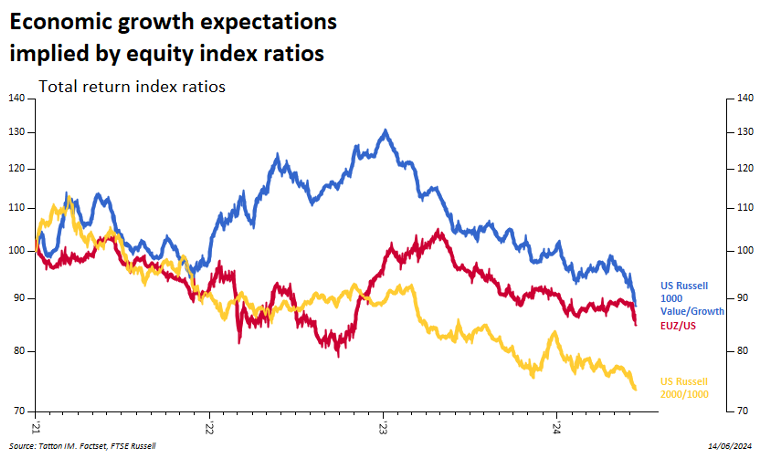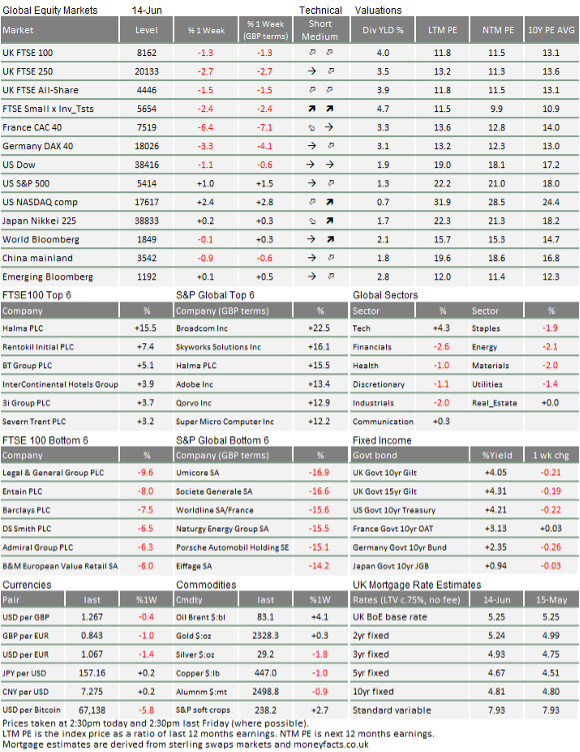Market Update: Still mostly sticking to the plan

European electorate, Adam D. Thompson, 12 June 2024
Still mostly sticking to the plan
In a week where politics seemed to drive markets, it was central banks and ever-changing economic growth expectations that made the real difference.
Macron makes an educated bet
Bond markets were concerned, but only time will tell if snap elections in France hold off the far right in parliament as Macron responds to his EU parliamentary losses.
Peso struggles despite election continuity
Markets voted ‘no’ to Mexico’s continuation government’s super majority but is the response too much?
Still mostly sticking to the plan
After a cacophony of political noise, central bankers were again the ones to really strike a chord with capital markets last week. Britain’s political parties unveiled their manifestos and French President Macron shocked everyone with a surprise election call – causing fairly significant market consternation – but it was an updated interest rate forecast from the US Federal Reserve (Fed) that turned out to be the key driver of markets. The Fed signalled it would cut interest rates just once this year, disappointing those who were betting on two cuts. This was called “hawkish” by the media, but we think “bullish” is probably more appropriate. It was more about recognising economic strength than a preference for higher rates.
UK underperforms, but don’t blame elections.
First off, we should say something about manifesto releases from Labour and the Conservatives. UK investors are understandably anxious to hear how the election and future government might affect their portfolios, but the answer is, once again, probably very little. Labour is expected to win a majority, but not change much about the UK economy or the fiscal position as far as asset prices over the short-to-medium term are concerned – particularly when compared to the market upheaval the ill-fated Liz Truss government managed to cause. The policy-lite manifesto Keir Starmer’s party unveiled last week did nothing to change those expectations.
Interestingly, the few weeks since Rishi Sunak announced the election have coincided with a pretty dour period for UK stocks, and right after a period of outperformance for UK assets, too. But this is probably a coincidence. Britain’s biggest stocks did well in previous months because the group is dominated by banks, multinational energy and commodities companies – stocks that usually do well when the wheels of the global economy turn to expansion. Global growth positivity has slowed in recent weeks, with a distinct shift back to the US megacap stocks, with their seeming immunity to economic downturns.
On the plus side, UK stocks still have cheap valuations compared to international peers, and the longer-term growth case is not damaged (in fact many economists suspect it might be marginally improved) by the widely expected imminent switch in government. What the Bank of England does will be much more important for UK assets and, on that front, it looks like the bank has more room to cut rates than international counterparts. Recent inflation data was barely above the 2% target, and markets are evenly split on whether the BoE will cut this month.
Fed signals economic positivity – not hawkishness.
After multiple signals that US inflation had come down significantly, markets thought the Fed would validate their implied expectations of two quarter-point rate cuts this year. But the Fed’s ‘dots plot’ – which shows committee members’ expected rate paths over the next few years – revealed that officials expect to cut rates just once in 2024.
This was called a “hawkish” move by financial media, but US stocks still ended last week up. This is because the Fed’s update was more about acknowledging the US economy’s strength and resilience than turning hawkish. Indeed, in the press conference, Jerome Powell acknowledged that recent economic data had been soft – perhaps a signal that he personally would be inclined to cut rates sooner rather than later.
Some recent US inflation data has indeed been soft – including May’s CPI print of 3.3%, released only a few hours before the Fed’s dots plot announcement. But other sources are still pointing toward US strength, such as the outsized jobs increase reported last week: 272,000 jobs were added in the US last month, smashing expectations of 185,000.
It is an open question whether this job market strength will lead to renewed inflationary pressure. What is not up for debate, however, is that the US economy is stronger than other regions and still stronger than most expected it to be at this stage of the cycle. This strength is giving the Fed pause. As the dots plot shows, officials still plan to cut rates this year, but they need to see more evidence that the current gentle slowdown in US growth is sufficient to keep inflation from flaring up again.
That makes perfect sense, and markets are unlikely to interpret this as a negative signal about the US economy or financial conditions. Central bankers are sticking to the rate cut plan, just getting more realistic about how, when and to what magnitude it can be implemented.
Investors flock back to tech megacaps, a possible warning sign for global growth.
At the time of writing, the Bloomberg World Equity Index is showing a tiny overall gain since the end of last week in Sterling terms, but the distribution of returns across sectors and regions is skewed. Across the board, stocks are more down than up, with just the top 5 positive contributors – Apple, Broadcom, Nvidia, Microsoft and Taiwan Semiconductor – skewing the markets overall back into positive territory. The most negative contributor has been JP Morgan but most of the bottom quintile come from Europe.
LVMH was Europe’s worst performer. The luxury goods company is caught between a rock and a hard place, with its home base being disrupted by Macron’s remarkable decision to call for a parliamentary election (upon which we write below) and yet more signals of poor demand in its biggest market, China.
Europe did badly last week, France leading the way down with a 5% loss. Often, as Europe is more cyclical than the US, underperformance can be related to slower global growth expectations (see red line in the chart below). One might expect slower growth in Europe, given the political upheaval, but there are also other signals of slower growth expectations. In the US itself, the Russell 2000 (the 2000 stocks with market cap below the top 1000 in the Russell 1000 index) has been slipping back relatively since the start of May and absolutely since mid-May (the yellow line shows the Russell 2000’s relative performance). And within the top Russell 1000 index, the value-oriented stocks have been underperforming the growth stocks (shown by the blue line).

Together, these signals seem to add up to weakening investor perceptions of the economic growth outlook globally, and even within the US. This went hand-in-hand with the recent decline in global bond yields – at least until political uncertainty intervened. Next Friday, we have the release of the latest business sentiment readings in the form of the “flash” regional purchasing manager indices. It seems to us that these more forward-looking data could set the scene for the equity markets through much of the Summer, coming just as we head into the Q2 earnings season.
Following the very strong run, markets feel a little fragile. It has been powered by a strong run up in earnings expectations which is starting to seem questionable given the run of softer economic data. However, it is perfectly possible that the data could start to turn better, much as it did this time last year. Should that be the case, we would see the pro-cyclical assets – ie. the laggards of the rally of the past 12 months – do well, with a lot of room to rebound from the recent underperformance.

This week’s writers from Tatton Investment Management:
Lothar Mentel
Chief Investment Officer
Jim Kean
Chief Economist
Astrid Schilo
Chief Investment Strategist
Isaac Kean
Investment Writer
Important Information:
This material has been written by Tatton and is for information purposes only and must not be considered as financial advice. We always recommend that you seek financial advice before making any financial decisions. The value of your investments can go down as well as up and you may get back less than you originally invested.
Reproduced from the Tatton Weekly with the kind permission of our investment partners Tatton Investment Management
Who are Vizion Wealth?
 Our approach to financial planning is simple, our clients are our number one priority and we ensure all our advice, strategies and services are tailored to the specific individual to best meet their longer term financial goals and aspirations. We understand that everyone is unique. We understand that wealth means different things to different people and each client will require a different strategy to build wealth, use and enjoy it during their lifetimes and to protect it for family and loved ones in the future.
Our approach to financial planning is simple, our clients are our number one priority and we ensure all our advice, strategies and services are tailored to the specific individual to best meet their longer term financial goals and aspirations. We understand that everyone is unique. We understand that wealth means different things to different people and each client will require a different strategy to build wealth, use and enjoy it during their lifetimes and to protect it for family and loved ones in the future.
All of us at Vizion Wealth are committed to our client’s financial success and would like to have an opportunity to review your individual wealth goals. To find out more, get in touch with us – we very much look forward to hearing from you.
The information contained in this article is intended solely for information purposes only and does not constitute advice. While every attempt has been made to ensure that the information contained on this article has been obtained from reliable sources, Vizion Wealth is not responsible for any errors or omissions. In no event will Vizion Wealth be liable to the reader or anyone else for any decision made or action taken in reliance on the information provided in this article.

